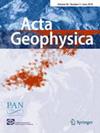喜马拉雅山脉中部地壳变形的运动学
IF 2.1
4区 地球科学
Q2 GEOCHEMISTRY & GEOPHYSICS
引用次数: 0
摘要
利用一组更新的GPS地表速度,本研究提供了沿喜马拉雅中部喜马拉雅主逆冲(MHT)的断锁行为和滑动速率分布。通过贝叶斯反演反演二维速度场,估计喜马拉雅中部MHT断层的几何形状和运动学参数。模拟结果表明:(1)MHT完全锁定在上平原(0 ~ 9 km),部分锁定在地壳中斜坡(15 ~ 21 km),并向较深的平原(0 ~ 21 km)蠕动;(2)在锁闭-蠕变过渡区,mhc滑移率不显著,表明其具有部分耦合/锁闭特性;(3)沿尼泊尔西部、中部和东部,沿MHT较深的平原,估算爬升速率分别为~16.3mm/yr、~14.7 mm/yr和~14.3 mm/yr;(4)沿上地壳MHT,模拟锁定宽度在尼泊尔西部、中部和东部分别为97 km、106 km和129 km。此外,锁定宽度的后验概率分布呈现双峰高斯分布,与沿尼泊尔西部的两个斜坡几何形状相一致。沿高喜马拉雅山麓,互锁线也与沿喜马拉雅中部估计的最大剪切应变集中和观测到的地震活动性对齐。与以前的大地测量结果、地质估计和背景地震活动大致一致,我们的发现为尼泊尔喜马拉雅地区的当代地壳变形提供了一条有希望的途径。在贝叶斯框架下估计的反演结果显示了MHT的更新断层运动学,因此为喜马拉雅中部的地震危险性评估提供了有价值的输入。本文章由计算机程序翻译,如有差异,请以英文原文为准。
Kinematics of Crustal Deformation along the Central Himalaya
Using an updated set of GPS surface velocities, the present study provides fault
locking behavior and slip rate distribution of the Main Himalayan Thrust (MHT) along
the central Himalaya. The two-dimensional velocity field is inverted through Bayesian
inversion to estimate fault geometry and kinematic parameters of the MHT along the
central Himalaya. The modeling results reveal that: (1) MHT is fully locked in the upper
flat (0-9 km), partially locked along the mid-crustal ramp (15-21 km), and it is creeping
in the deeper flat (> 21 km); (2) there is an insignificant slip rate of MHT
along the locked-to-creeping transition zone, indicating its partially coupled/locked
behavior; (3) along the deeper flat of the MHT, the estimated creeping rate is ~16.3
mm/yr, ~14.7 mm/yr, and ~14.3 mm/yr along western, central, and eastern Nepal,
respectively; and (4) along the MHT on the upper crust, the modeled locking width
turns out to be 97 km, 106 km, and 129 km in the western, central, and eastern Nepal,
respectively. In addition, the posterior probability distribution of the locking width
exhibits a bimodal Gaussian distribution coinciding with the two ramp geometry of the
MHT along the western Nepal. Along the foothills of the Higher Himalaya, the inferred
locking line is also aligned to the estimated maximum shear strain concentration and
observed seismicity along the central Himalaya. With a general agreement to the
previous geodetic results, geological estimates, and background seismicity, our
findings provide a promising avenue of the contemporary crustal deformation along the
Nepal Himalaya. The estimated inversion results in a Bayesian framework exhibit
updated fault kinematics of the MHT and hence provides valuable inputs for seismic
hazard assessment along the central Himalaya.
求助全文
通过发布文献求助,成功后即可免费获取论文全文。
去求助
来源期刊

Acta Geophysica
地学-地球化学与地球物理
CiteScore
3.90
自引率
13.00%
发文量
251
审稿时长
5.3 months
期刊介绍:
Acta Geophysica is open to all kinds of manuscripts including research and review articles, short communications, comments to published papers, letters to the Editor as well as book reviews. Some of the issues are fully devoted to particular topics; we do encourage proposals for such topical issues. We accept submissions from scientists world-wide, offering high scientific and editorial standard and comprehensive treatment of the discussed topics.
 求助内容:
求助内容: 应助结果提醒方式:
应助结果提醒方式:


